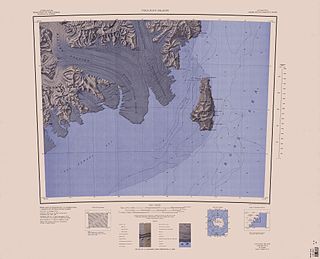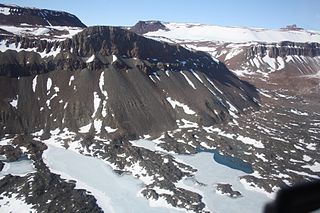
The Usarp Mountains is a major Antarctic mountain range, lying westward of the Rennick Glacier and trending N-S for about 190 kilometres (118 mi). The feature is bounded to the north by Pryor Glacier and the Wilson Hills. Its important constituent parts include Welcome Mountain, Mount Van der Hoeven, Mount Weihaupt, Mount Stuart, Mount Lorius, Smith Bench, Mount Roberts, Pomerantz Tableland, Daniels Range, Emlen Peaks, Helliwell Hills and Morozumi Range.

Borchgrevink Glacier is a large glacier in the Victory Mountains, Victoria Land, draining south between Malta Plateau and Daniell Peninsula, and thence projecting into Glacier Strait, Ross Sea, as a floating glacier tongue, the Borchgrevink Glacier Tongue, just south of Cape Jones. It was named by the New Zealand Geological Survey Antarctic Expedition, 1957–58, for Carsten Borchgrevink, leader of the British Antarctic Expedition, 1898–1900. Borchgrevink visited the area in February 1900 and first observed the seaward portion of the glacier.
The Illusion Hills are small escarpment-like hills located between the Lichen Hills and the Vantage Hills at the head of Rennick Glacier in Victoria Land, Antarctica. They were named by the northern party of the New Zealand Geological Survey Antarctic Expedition, 1962–63, because they were found to be much more distant than anticipated. These hills lie situated on the Pennell Coast, a portion of Antarctica lying between Cape Williams and Cape Adare.

Barnett Glacier is a large glacier in the Anare Mountains that flows east along the south side of Tapsell Foreland into Smith Inlet, northern Victoria Land, Antarctica. It was mapped by the United States Geological Survey (USGS) from surveys and from U.S. Navy air photos, 1960–63, and named by the Advisory Committee on Antarctic Names after Donald C. Barnett, USGS topographic engineer, a member of USGS Topo East and West, 1962–63, in which the expedition extended geodetic control from the area of Cape Hallett to the Wilson Hills and from the foot of Beardmore Glacier through the Horlick Mountains. The glacier lies on the Pennell Coast, a portion of Antarctica lying between Cape Williams and Cape Adare.
Barren Bluff is a prominent rock bluff in the south part of the Sequence Hills along the west side of upper Rennick Glacier, Victoria Land, Antarctica. The geographical feature was so named by the northern party of the New Zealand Geological Survey Antarctic Expedition, 1962–63, because of the extremely bare and exposed nature of the surface; the party had difficulty collecting sufficient stones for construction of a survey beacon. The bluff lies on the Pennell Coast, a portion of Antarctica lying between Cape Williams and Cape Adare.

Boggs Valley is a glaciated valley, heavily strewn with morainal debris, which indents the east side of the Helliwell Hills between Mount Van der Hoeven and Mount Alford, Victoria Land, Antarctica. The geographical feature was first mapped by the United States Geological Survey from surveys and from U.S. Navy air photos, 1960–63, and named by the Advisory Committee on Antarctic Names for William J. Boggs, United States Antarctic Research Program biologist who performed his biological observations while situated at McMurdo Station, Hut Point Peninsula, Ross Island, during the summer of 1967–68. The valley lies situated on the Pennell Coast, a portion of Antarctica lying between Cape Williams and Cape Adare.

Mount Bresnahan is a flat-topped, mainly ice-free mountain, 1,630 metres (5,350 ft) high, situated along the east side of the Helliwell Hills, 6 nautical miles (11 km) north-northeast of Mount Van der Hoeven, situated in Victoria Land, Antarctica. The topographical feature was first mapped by the United States Geological Survey from surveys and from U.S. Navy air photos, 1960–63, and named by the Advisory Committee on Antarctic Names after David M. Bresnahan, a United States Antarctic Research Program biologist at McMurdo Station, Hut Point Peninsula, Ross Island, 1967–68 and 1968–69, and on the staff of the Office of Polar Programs, National Science Foundation, from 1970. The mountain lies situated on the Pennell Coast, a portion of Antarctica lying between Cape Williams and Cape Adare.
The Brien Rocks are a group of prominent rock outcrops lying 6 nautical miles (11 km) west of the Caudal Hills, in Victoria Land, Antarctica. They were mapped by the United States Geological Survey from surveys and from U.S. Navy air photos, 1960–64, and were named by the Advisory Committee on Antarctic Names for Robert J. Brien, an aviation electronics technician with U.S. Navy Squadron VX-6 at McMurdo Station, Hut Point Peninsula, Ross Island, 1966. These rock formations lie situated on the Pennell Coast, a portion of Antarctica lying between Cape Williams and Cape Adare.
The Canine Hills are a line of mostly snow-covered hills and ridges trending northwest–southeast for 11 nautical miles (20 km) and forming the eastern half of Molar Massif in the Bowers Mountains, a major mountain range situated in Victoria Land, Antarctica. They were named by the New Zealand Antarctic Place-Names Committee in 1983 from a proposal by geologist M.G. Laird, after canine teeth, in association with other tooth-related names nearby: Molar Massif and Incisor Ridge. The hills lie situated on the Pennell Coast, a portion of Antarctica lying between Cape Williams and Cape Adare.
The Charybdis Icefalls are a large group of crevassed icefalls in the lower portion of Harlin Glacier, where it descends notably to join the Rennick Glacier at Victoria Land in Antarctica. The feature is nourished in part by the Lovejoy Glacier which flows eastward parallel to the Harlin Glacier's north side and coalesces with it before reaching the icefalls. It was first mapped by the United States Geological Survey (1962–63) and the New Zealand Geological Survey Antarctic Expedition (NZGSAE) (1963–64), and named by the latter after Charybdis, the fearsome whirlpool monster of Greek mythology. The icefalls lies situated on the Pennell Coast, a portion of Antarctica lying between Cape Williams and Cape Adare.
Church Ridge is a southwest-trending ridge, 10 nautical miles (19 km) long, with several peaks over 2,000 metres (6,600 ft) high. The ridge separates the flow of nearby Church Glacier and Leander Glacier in the Admiralty Mountains, a major mountain range lying situated in Victoria Land, Antarctica. The ridge was mapped by the United States Geological Survey from surveys and from U.S. Navy aerial photography, 1960–63, and named by the Advisory Committee on Antarctic Names for Commander A.E. Church, U.S. Navy, assistant chief of staff for civil engineering with the U.S. Naval Support Force, Antarctica, 1967 and 1968. The ridge lies on the Pennell Coast, a portion of Antarctica lying between Cape Williams and Cape Adare.
Clingman Peak is 2,150 metres (7,050 ft) high, and is the final peak along the south wall at the head of Priestley Glacier, in Victoria Land, Antarctica. The topographical feature was first mapped by the United States Geological Survey from surveys and from U.S. Navy air photos, 1960–64, and named by the Advisory Committee on Antarctic Names for Otis Clingman, Jr., biologist at McMurdo Station, Hut Point Peninsula, Ross Island, 1965–66. The peak lies situated on the Pennell Coast, a portion of Antarctica lying between Cape Williams and Cape Adare.

Mount Cox is a mountain 1,960 metres (6,430 ft) high in the north-central part of the Emlen Peaks, 5 nautical miles (9 km) north of Killer Nunatak, Victoria Land, Antarctica. The topographical feature was first mapped by the United States Geological Survey (USGS) from surveys and from U.S. Navy air photos, 1960–63, and named by the Advisory Committee on Antarctic Names for Allen N. Cox, U.S. Navy, crew chief in R4D (Skytrain) aircraft during 1962–63 in support of the USGS Topo East-West survey. Cox returned to the Antarctic in the 1963–64 and 1964–65 seasons. The mountain lies situated on the Pennell Coast, a portion of Antarctica lying between Cape Williams and Cape Adare.
Dodd Nunatak is a nunatak 2.5 nautical miles (5 km) west of Mount Cox in the northwest portion of the Emlen Peaks in the Usarp Mountains, a major mountain range within Victoria Land, Antarctica. The geographical feature was first mapped by the United States Geological Survey from surveys and U.S. Navy air photos, 1960–63, and was named by the Advisory Committee on Antarctic Names for Walter H. Dodd of the Public Information Office, National Science Foundation, who worked at McMurdo Station, Hut Point Peninsula, Ross Island, in the 1966–67 and 1967–68 austral summer months. The nunatak lies situated on the Pennell Coast, a portion of Antarctica lying between Cape Williams and Cape Adare.
Pinet Butte is a small butte comprising the westernmost portion of the Caudal Hills, in Victoria Land. Mapped by United States Geological Survey (USGS) from surveys and U.S. Navy air photos, 1960-64. Named by Advisory Committee on Antarctic Names (US-ACAN) for Paul R. Pinet, geologist at McMurdo Station, 1966-67.
Egeberg Glacier is a small glacier between Scott Keltie Glacier and Dugdale Glacier, flowing into the west side of Robertson Bay, Victoria Land, Antarctica. The glacier lies situated on the Pennell Coast, a portion of Antarctica lying between Cape Williams and Cape Adare.
The Fitzsimmons Nunataks are a group of small nunataks about 27 nautical miles (50 km) east-northeast of Welcome Mountain of the Outback Nunataks and 8 nautical miles (15 km) southeast of the Helliwell Hills, Victoria Land, Antarctica. They were mapped by the United States Geological Survey from surveys and U.S. Navy air photos, 1959–64, and were named by the Advisory Committee on Antarctic Names for John M. Fitzsimmons, a biologist at McMurdo Station, Hut Point Peninsula, Ross Island, 1965–66. This geographical feature lies situated on the Pennell Coast, a portion of Antarctica lying between Cape Williams and Cape Adare.
Foggy Pass is a pass running northeast–southwest between the Leitch Massif on the north and West Quartzite Range and East Quartzite Range on the south, in the Concord Mountains of Victoria Land, Antarctica. The mountain pass was so named by the New Zealand Antarctic Place-Names Committee in 1983, on a proposal from geologist M.G. Laird, from the weather conditions encountered in the area. This geographical feature lies situated on the Pennell Coast, a portion of Antarctica lying between Cape Williams and Cape Adare.
Folk Ridge is a ridge just southeast of Moore Ridge and parallel to it in the Caudal Hills of Victoria Land, Antarctica. The ridge was first mapped by the United States Geological Survey from surveys and U.S. Navy air photos, 1960–64, and was named by the Advisory Committee on Antarctic Names for John E. Folk, a biolab technician at McMurdo Station, Hut Point Peninsula, Ross Island, 1965–66. The feature lies situated on the Pennell Coast, a portion of Antarctica lying between Cape Williams and Cape Adare.
Hewitt Glacier is a glacier, 15 nautical miles (28 km) long, descending the eastern slopes of the Holland Range, Antarctica, between Lewis Ridge and Mount Tripp to enter Richards Inlet. It was named by the New Zealand Geological Survey Antarctic Expedition (1959–60) for Leonard R. Hewitt, leader at Scott Base, 1959.








